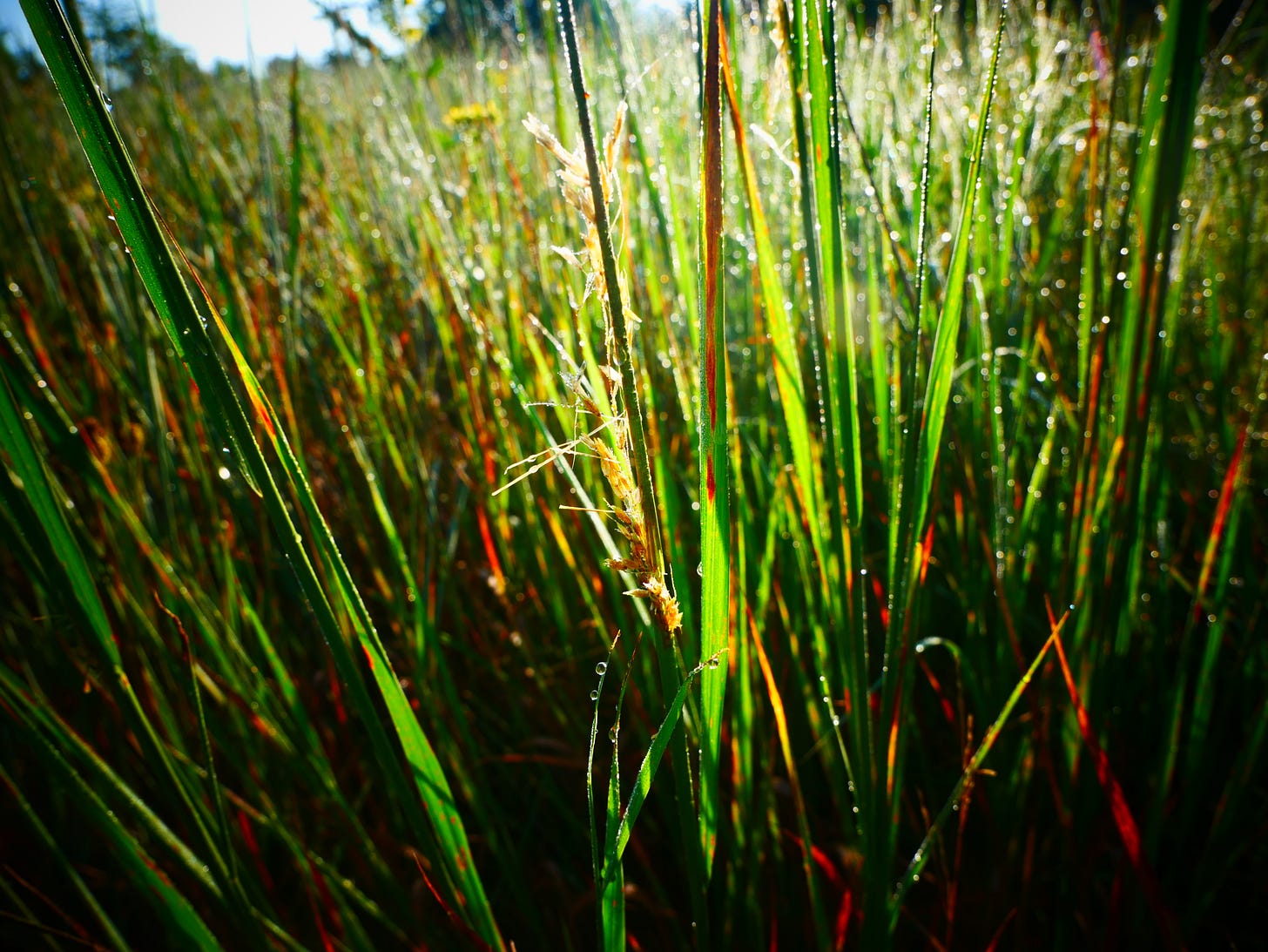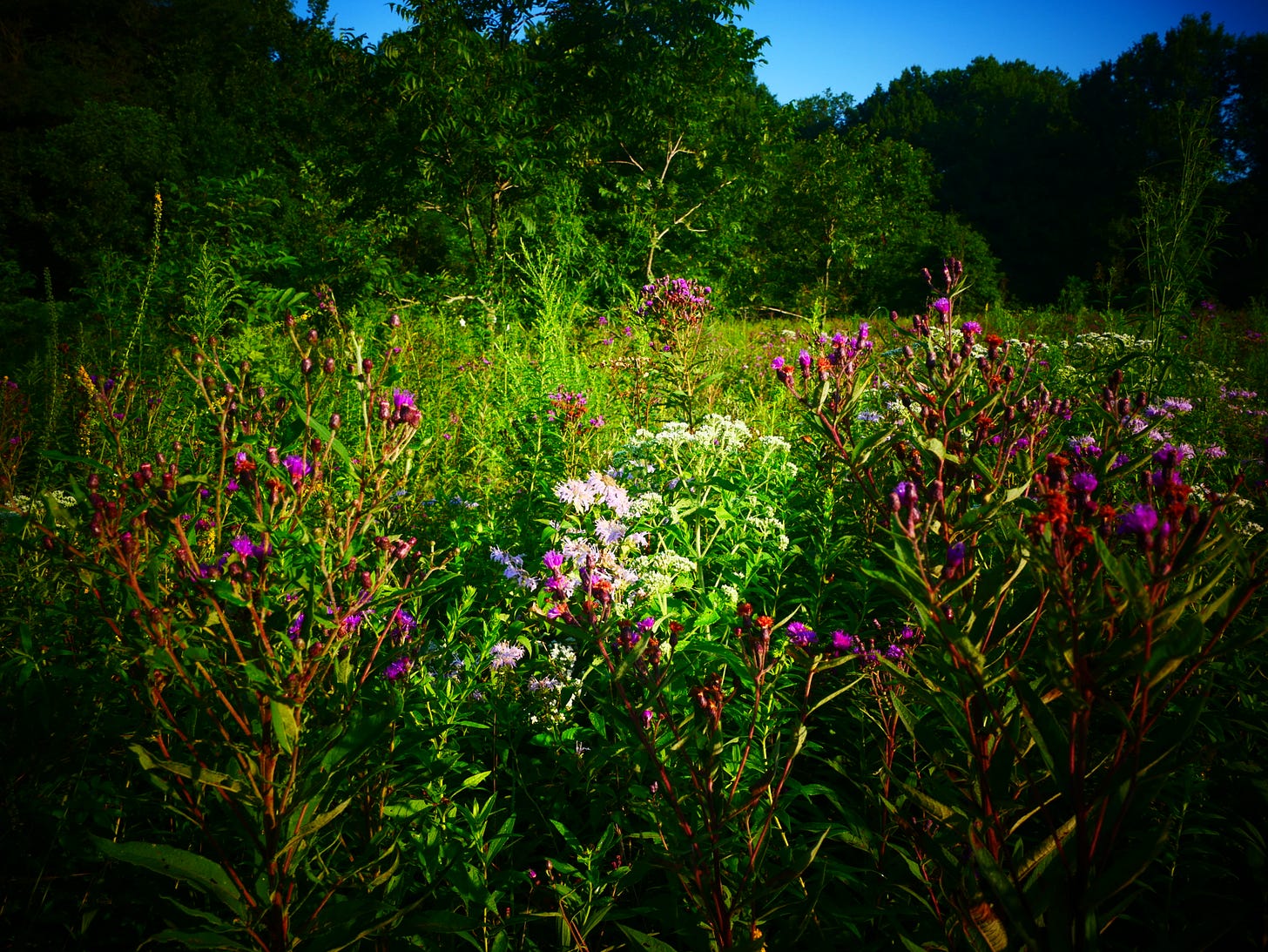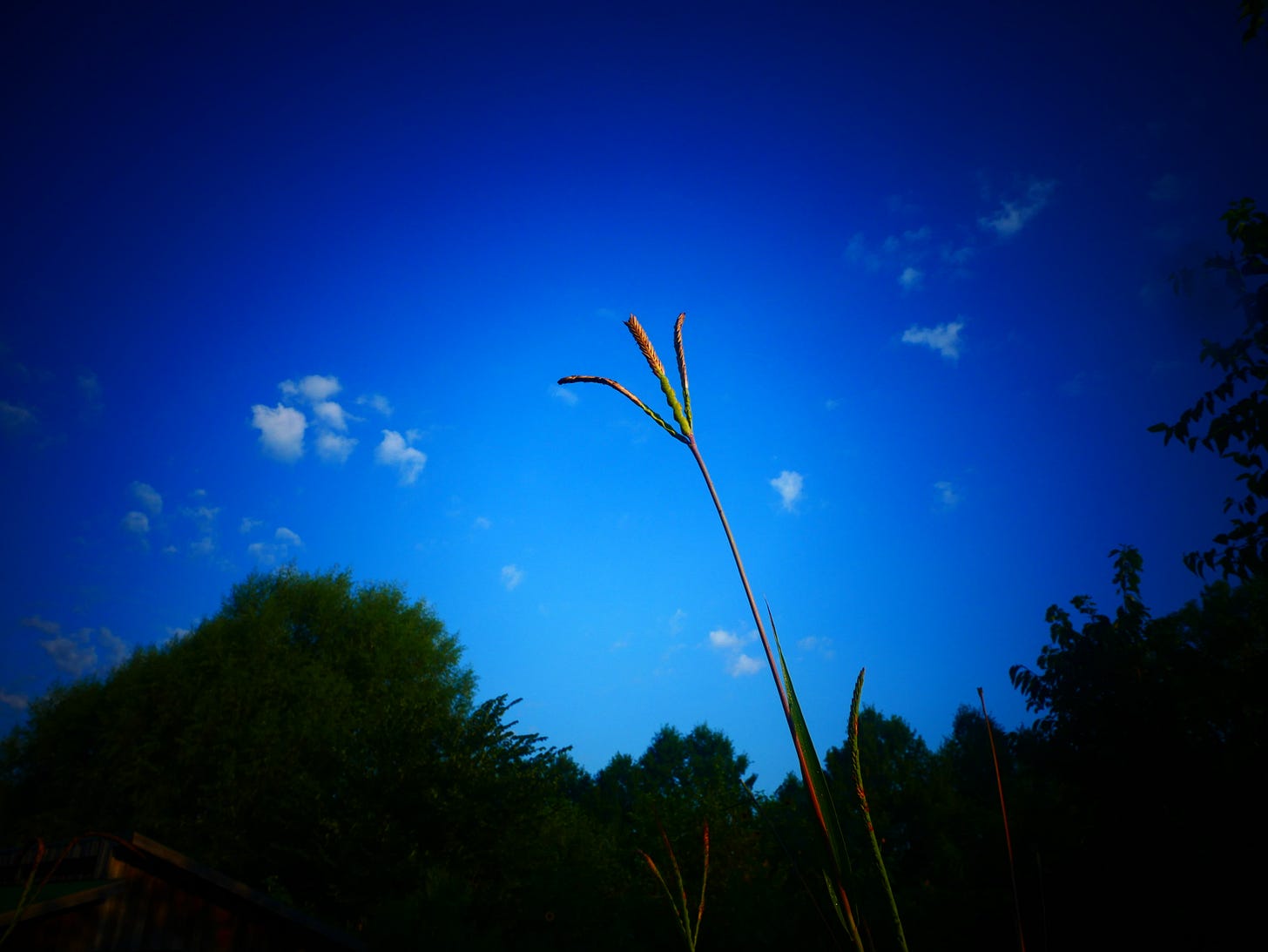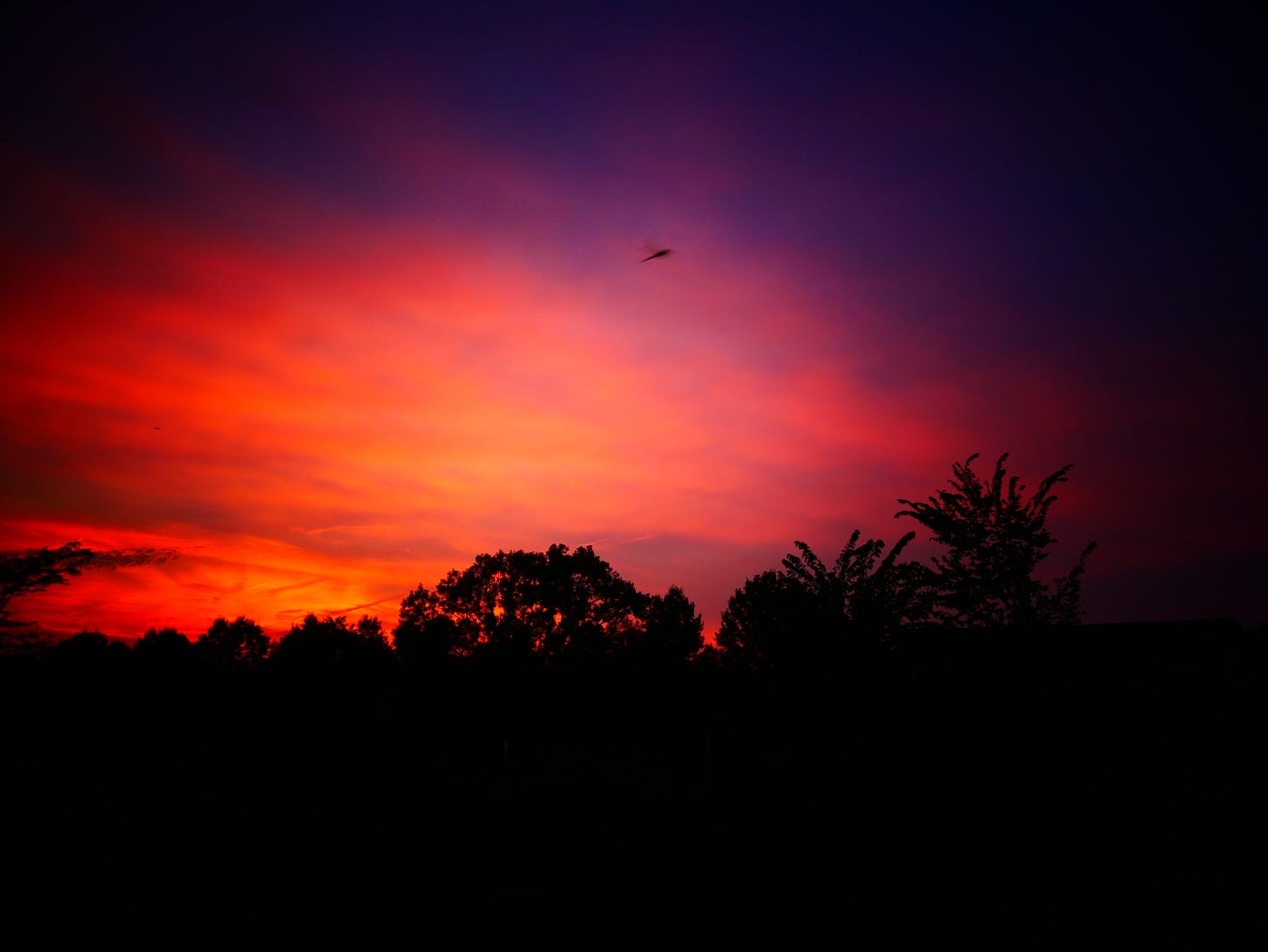Hay Fever and Lignification
Practicing the good hard work of farming and writing
In these dog day mornings, with the heat already threatening to singe every living thing on this farm just below the dewdrop horizon of dawn, I scythe through head-high swathes of wet prairie grass which grows more hardened, stemmy and lignified with each dragging summer day. Step-by-step and slash-by-slash, I lay down dense windrows of blue-green cellulose, keeping my feet planted firmly in the stubble and my eyes in the foreground, doing my best to avoid under-represented prairie plants and dewy spider webs here on the pasture. A constant stream of thin snot runs from my nostrils –it is once again hay fever season, and this is the penance of my disturbance. Foot by foot, traces of slain stems trail through the buzz and heat of August prairie, gradually forming the boundaries of paddocks, each swishing cut releasing a fine vapor of night dew into the low rays of sunrise.
In recent days, the stems of Sorghastrum nutans have stretched skyward and hardened in preparation for flowering, making them much more difficult to mow down. As summer staggers on, the once soft, lush growth of grasses and forbs has thickened –plants like the aptly named common ironweed (Veronia fasciculata)– have armored themselves with lignin-rich, secondary cell walls. The result is that these tough stands of brilliant purple flowers feel like I am scything a field of dense bones. My sharp, thin grass blade cannot stand up to these tough stalked plants, so I’ve transitioned to a much burlier, heavy brush blade. The blade moves in slow bites, whoofing and crunching through the sward of forbs at a slow, consistent pace while sweat burns my eyes and tributaries of clear mucus run through my moustache. It may take twenty or thirty minutes of this to outline a new paddock, by which time I am covered in a mix of sweat, dew, and snot.
Crowding nearly against the hot wire, the pigs anticipate fresh pasture and grunt with impatience as I trace the lane slowly. Spring scything is like a dance; in August, it becomes a dirge. Turning the corner toward the final hundred feet of lane, I whoof my blade until it suddenly stops, caught in the woody, lignous stalk of a six foot tall ragweed –and in the hot glow of the now-risen sun– I watch as golden pollen showers from the undefeated plant, smoking in the haze and dew.
Both the common and great ragweed (Ambrosia artemisiifolia and Ambrosia trifida) are majorly irritating plants; a leading cause of allergic rhinitis, otherwise known as hay fever, a condition which I am deeply afflicted with. I am not a big complainer in regards to my physical conditions, but hay fever season is another story. Ragweed could be considered an aggressive generalist plant. It is native to much of North America, the Caribbean, and parts of South America, though through introduction and functions related to climate change, its range is expanding. Its small seeds are rich with protein and fat, and some evidence suggests it was a cultivated crop as far back as 4,000 years as part of the Eastern Agricultural Complex. I have watched both turkeys and goats relish the ripe seeds. It is a favorite seed crop for songbirds and upland game birds, and it was recorded to be a common medicinal plant among the Otoe, Cherokee, Lakota, Iroquois, Dakota, and Delaware people. It is also a valuable plant for phytoremediation, noted for its ability to suck up lead contamination in soils.
The pollen is able to travel hundreds of miles on the wind, being traced at least 400 miles at sea and 2 miles up in the sky– so while I do my best every year to keep the ragweed crop under control with frequent, early mowing, the stuff is just in the air wherever I go, throughout the month of August and into early September. Some folks with severe hay fever attempt to control their allergies through hygiene –limiting outdoor time, covering couches and bedding with zippered, pollen-proof bags, showering after short exposure to pollen, and the like.
Personally, I’ve never condoned a high level of hygiene, and none of these approaches are practical for me in my day-to-day existence as a dirt person who largely lives outside, so I opt for the standard mix of suffering and pharmaceuticals. Each year it takes a while to find the proper drug cocktail to keep me functional, and it often takes a week or so for the drugs to accumulate in my system and begin working. Until that time, I sneeze, tear up, drip snot copiously, and sometimes get full body aches, and exist in a generally miserable physical condition. I do publicly complain, but I also take this time of year to reflect on my impacts, as a person engaged with land.
Ragweed thrives on disturbance. Whenever we leave the earth bare, when we rut the wet sod with machines in the springtime, when we overgraze, or fail to re-seed eroded ground, ragweed springs from the ancient seedbank to correct the errors of our species, providing quick cover and a sturdy root system to fix what we’ve broken. As for the pollen, perhaps that exists to keep us away from meddling in these areas which we have stewarded poorly. So instead of cursing the plant, I choose to meditate on the steady trickle of mucus running down my face for days at a time– perhaps I’ll learn a lesson from it sometime.
Wheezing and dripping snot in the shade of a young white oak, the gilded pollen of ragweed stuck to my sweating, prickling skin, I reflect for a minute next to my empty water bottle. I am moving the pigs along a low saddle of prairie land that is intercepted with a mix of bottomland trees –oaks, sycamores, and walnuts– that gives way to an undulating slope of thickening asters and bergamot, swamp milkweed, silphium, and ironweed. The faintest, pollen-laden breeze sweeps over the heavy stalks in slow ripples, and I begin to notice monarch butterflies lazily bobbing plant to plant, drinking in the sweet prairie. It could be the heat, but after a few minutes, I count 42 monarchs in all. Others are here too… swallowtails and clouded sulphurs and painted ladies all whoofing through the morning heat. They have long journeys ahead– and I feel honored to provide them with their needed forage, in a world increasingly gone to disturbance and ragweed.
My damp, sticky pockets contain a few seeds– earlier ripening coneflowers, daisies, and the like. With sweat in my eyes and snot all over, I sprinkle the mix of seed, chaff, and pocket lint out over the hog wallows on the old paddock, before lifting the hot wire and herding my swine on into their next field. Taking up my blade, dulled by the woody growth of a prairie surging towards seed and reproduction, I walk against the grain of grassy pathways, the sole standing blades of unmown forbs acting as perches for the waking dragonflies that dry their wings in the heat and sun. By the time I return home, past the masticating cattle who graze low between the burning purple towers of ironweed, up along the small crops of branching ragweed that have emerged from where chickens earlier scratched the spring sod into mud, I have lost count somewhere around 80 monarchs.
Moments before I can refill my water, I get the call– our hay is ready to be delivered. With hay fever comes hay season, and with this summer being notably wet, the job of getting freshly baled squares into our hay loft cannot be delayed. Our loft is not easy to access– and the original cantilevered platform that we used to be able to chuck the bales onto from the top of the wagon fell off recently, meaning we needed to convey the bales –usually around sixty pounds apiece– by way of a crude slide, hastily made with crooked boards. It is hot, hard work. Each bale emits a bit of fine, sharp chaff that sticks to sweaty skin, fills your boots, and obstructs my breathing. The top course of bales on a wagon full of hay is the easiest to pitch, but as we toil, and our arms burn from lifting and heaving the scratchy fodder course by course, they get heavier– or at least we become tired.
With every bale that we toss, slide, heave, lift and stack, I think forward to winter, when we will inevitably chuck these bales back down out of the loft, and once again heave them into mangers, where they will become flesh, milk, and manure, which must also be appropriately moved or otherwise handled. Agriculture is essentially the movement of metabolic energy harvested from sunlight, from point to point, ideally forming a nice neat circle.
Condensed solar energy, caloric resources, piles of shit– call it what you will, we have lots of stuff here, and what I’ve observed is that the more we make stuff move from point-to-point, and the more we replenish the moved piles of stuff, the more people have to eat, the more soil is regenerated, and the more we are able to strengthen the brittle nature of our starved midwestern ecology. When agriculture functions best, we move shit around. Agriculture –and the civilization it has spawned– fails when the resources cease to flow, when the circle of energy frays and breaks and stockpiles of calories and wealth form, when the soil –and everything which derives life from it– goes hungry and unreplenished.
I sometimes forget, when I’m attempting to write cleverly, or poetically, or with whatever nuance or wit I can muster through the pall of snot that runs down my face, that I type these words with very rough hands. Over the years, they’ve become calloused, worn, and lignified. It took some time to get here, and I’m not a naturally hard-working person– just a person motivated to work hard for the right reasons. Season upon season, like common ironweed, I feel myself toughening, though I sometimes wonder where the line between calloused and crumbling lies. The hay bales at the bottom course of the wagon don’t grow any lighter, and I don’t grow more immune to the heat and snot and pain. Instead, I only grow accustomed to the weight.
Lignification in plants –that is the polymerization of vascular cell material which results in woodiness– is an adaptation to the stresses of bacterial and fungal decay. In the long game of seed production, particularly in a tall-grass setting where prairie plants must reach and compete for light, a strong, rot-resistant stem is necessary for flowering and dissemination. It helps the plant to stand tall and stable above the canopy of grass, where it can be pollinated, and disperse seed. And while it is unlikely for a plant to feel growing pains in this process, I sometimes do. Regardless, my own cycles of lignification, too, seem necessary. In the pages of this almanac, I find myself reaching towards some source, hoping to transmute what I learn from this place into viable seed. Perhaps this is the good, hard work– to move energy, with carts and hands and wagons and words.
Insect reproduction is at its peak, here at the zenith of photosynthesis, upon a hot prairie about to go to seed. The choral howl of cicadas drowns out the faint sound of thick-stemmed grasses that slap in the wind. As the heat of the day presses into evening, and the butterflies begin to go to wherever butterflies go in the nighttime, the old cow loafing yard adjacent to our barn, now full of hay, swarms with dragonflies. After dinner each night, they swirl and dance in the heavy air above the thick jungle of ragweed and bindweed and feral sunflowers– the soil’s salvation in the midst of our continued disturbance; the closure of the loop we opened. They rise from the wet grass and circle tightly around the barn, feasting on mosquitoes and gnats, the spiral of sun and water, earth and sky joining itself in neat rings. They feed themselves, shit, lay eggs, and prepare to die in the matter of a few short weeks. The monarchs, now sleeping, will do the same further south, pushing their progeny to overwinter in the warmth of more southerly latitudes.
The trellises in the garden hang heavy with fruit. Distracted and exhausted, I allow some overripe tomatoes to droop and rot. Soon, our dry bean plot will be ready to reap. While the air churns with a deep and inescapable heat, the first tumescent flowers of prairie grass have begun to rupture from tired stems, and the suggestion of harvest season arises here and there, in brief moments. The spiders have slung their webs in the dew, and the spiral has begun to tighten; the cattle and goats and swine, pastured further and further out into the landscape will return, fat with grass and solar energy, and I’ll be with them, covered in sweat and dew and pollen and snot, hoping to once again replenish what we’ve spent.
When I began this work, I was soft and foolish. At least I’m not so soft anymore. Autumn and winter will certainly bring their own challenges, but that is the nature of real farming, of bending energy into ever tighter rings. When we merge with the farmscape, rather than ride above it on clanking machinery, we should expect some physical feedback– aches, pains, stings and hay fever. Some particular callouses, like the ones I get from scything, will soften some between now and spring. Bale by bale, we will feed the hay we’ve put up, and if our work is to remain the good hard work, we will be steadfast in moving, scattering, and dispersing the things of life well through the dormant months– all the flesh, milk, shit, and seed made real by the sun we toil beneath. But I also hope to develop some new callouses, here at this damned keyboard. As I tease out that fine line between calloused and crumbled, I look forward to spending a bit more of my time engaged in the good, hard work from the confines of my creaky desk and chair, moving piles of words, like so much seed and manure, from point to point, in neat circles, to feed those who need it, and regenerate what we’ve degraded.









I am happy to report that this year, several years after taking some of our land out of row crop to restore a native pasture, the resident ragweed population has shrunk from a couple acres, to a couple hundred total plants, hiding in a scraggily corner.
Eighty monarchs!? That must be an amazing sight.